WCX
Rear Admiral
Hello fellow wingnuts! It’s been too long. How are you faring in these uncertain times?
Long ago, (in two colleges actually) I majored in cultural anthropology and minored in linguistics. Hs this gotten me a decent career job yet? Not really. Granted linguistics is more of a hobby for me than anything, but never the less - trained I am!
So one day I was sitting around, recalling the good old days of college, when I decide to do a little mental exercise. I’ll analyze the Killrathi language.
Why? For the lulz, of course.
Now, Kilrathi was never fleshed out as a full conlang (constructed language), instead owing its lexicon to a large number of authors. The end result? Chaos.
But you’ve got to start somewhere. So since the Wing Commander series is (for them most part) World War 2… IN SPACE! I feel it is not unwise to first compare Kilrathi to Japanese and German.
Now, before anyone loses their cool, let me say that I am going to do a LOT of speculating. Keep in mind that this is all theory and educated guess work based on the
LIMITED data we have, and I certainly welcome any and all creative feedback or opposing theories.
Finally, I want to warn you now that this is going to be LOOOOONG. So use the restroom, get a drink, make yourselves a sandwich, crank up Tiga & Zyntherius’ cover of “Sunglasses At Night” and read on!
So, without further a due, let’s begin with Kilrathi Ranks and Titles:
Firstly “Kal”, which supposedly means “lord”, appears to be used as “Senior”.
Nearly all the listed ranks or titles end with “-ar” or “-ahr”, which I assume to mean something like “leader” (the lone exception being “Kalahn”).
Base on the usage of these titles, I take “Shint” to mean “ship”, while “Khant” means “fleet”. Given the lofty position of a Kalralahr, I propose that “Kalral” mean “sector”.
LEXICON:
Kal = lord / senior
-ar / -ahr = leader
Shint = ship
Khant = fleet
Kalral = sector
trathkh = tongues
hyilgh = assistant (?)
takh = equal (?)
Now let’s get into the language proper. We’ll start with a very easy one:
Thrak = Great / ultimate / noble / final / top.
Similar to German “Uber” or Japanese “Dai
See: tr'thrak, kn'thrak, thrak'hra, Thrak'Kilrah, Thrakhath
Assuming that the Kilrathi language uses compound words, we can examine the meaning of Crown Prince Thrakhath’s name.
When his name is spoken, actors consistently pronounce it “Thrak-hath”, emphasis on the “H” in “hath”.
Now let’s quickly examine another name whose meaning we already know, “dakhath” (Deathstroke). Assuming that “dakhath” isn’t a single word, we can separate it into “dak-hath”.
In both cases we wind up with the word “hath”, which could mean either “Death/Killing” or “Stroke/Blow”.
If this is the case, than Thrakhath’s name translates into something like ‘Final Blow’, ‘Great Death’, ‘Final Kill’, ect.
Nothing really definitive, but it’s a start.
-'hra / -'ra = Possible suffix meaning “person” or “people”, similar to Japanese “-jin” (Amerikajin) or “–aner” in German “Amerikaner“ ,
See: Kilrath'ra, Terran'ra, kilrah'hra, thrak'hra, hrai, Hraijhak
If this is the case, than the “i” in hrai could be a plural marker, but most likely it is some other sort of grammatical case marker, quite possible genitive (i.e. hrai = “My people”)
This brings us to another unique example. The name Kilrathi, presumably their own. In dialogue the word “Kilrath'ra” is mentioned, which following this train of logic would suppose it to mean something like “Killrathi people” or “Kilrathi persons”
Yet if I recall correctly, it was in the book False Colors that the term “Kil” was used for any member of the Kilrathi race.
Thus I take “kil” to mean something similar to “person” (a single individual, ie. any man), while the 'hra / 'ra suffix is used when regarding a collective group of people or number of unknown persons. This, however, creates the mystery of the “rath” portion of Kilrathi, though this MIGHT be explained by examining two other words: “Lerkrath” and “Kalkrath”.
Now, in order to avoid homonyms, I’m going to split them up as “Lerk” (Drug / Chemical), “Kalk” (Torture), and “Rath” (interrogation / question).
If this is the case, then the “Rath” in Kilrathi has something to do with “Interrogation” or “Question”. In the case of context, maybe it actually means “dominate”.
Perhaps if the “i” in “hrai” and “Kilrathi” is a genitive marker, than the name Kilrathi may translate into something like: “My people who question” or “My people who demand answers”.
Ok, so this sounds more than a little silly, but it also has a slight defiant ring to it. Again, I’m grasping at straws here.
The more poetic (and loose) translation give us: “My people who dominate.”
Probably more fitting with the Kilrathi character.
Moving on, let’s crack some sentences.
Our study of thrak and 'hra / 'ra have consequently brought us to the phrase:
"Ek'rah skabak erg Thrak'Kilrah maks Rag'nith."
“For the glory of Kilrah, the Emperor and the Empire.”
This sentence is worth note because two words are capitalizes, as though they are proper nouns in English, but I’ll get to that in a bit.
Now, we know “skabak” is a word embodying the concept of “The will to die for the glory of Kilrah”, but in the context of the sentence, I take it to merely mean “the glory”.
“Thrak'Kilrah”, which I take to mean “Great Kilrah”, could refer to both the planet and the Empire as a whole, similar to “Greater Germany”.
Incidentally the word “Rag'nith”, which is capitalized, could mean Emperor or Empire. Or in keeping with the Kilrathi’s highly stratified hierarchy, it could be said (in a poetic and political sense) that the Emperor IS the Empire, and that this word has more nuance than the direct translation leads us to believe.
Now, the sentence structure of Kilrathi is unknown, but a more accurate translation of “Ek'rah skabak erg Thrak'Kilrah maks Rag'nith”
might read:
(We/our) glory (toward/at/for) Great-Kilrah and Emperor/ Empire
If this is so, then it gives us:
Ek'rah = “Us, we people”, again see the -'hra / -'ra suffix
“erg” = "to, in, at, by" indirect object or direction marker, like the Japanese particle “ni”.
“maks” = “and” (some kind of linking word or connector (Japanese “to” and “ya”)
grammatical conjunction)
The ship name “Agon Ra Sivar”, which I take to mean “Glory of Sivar” presents us with a few other lexical items.
Agon = Glory (possible noun), praise, honor.
Ra = “of/for”, similar to the Japanese possession indicator partial “no”.
Multiple words for Glory? Well, its like they say, the more important something is to a culture, the more words they have for it.
For more little tidbits lets look at the phrase “Huma ta humas”.
While this is descried as being archaic form, I thought I’d include just the same (just as quite a bit of Latin is used in modern English).
Now, since (according to Action Stations) it appears to have a direct translation in Latin, we’ll use the Latin rather than the English:
LEXICON:
Huma = this (compare Japanese “Kore”= This thing
Ta = for
Humas = that (compare Japanese “Sore”= That thing
Still with me? Ok. Let’s keep going.
Now, since we are fairly certain that “Thrak”is a word meaning “End-all, mother-of, ect.”, then the word “tr'thrak” and “kn'thrak” give us two new Kilrathi words/concepts:
LEXICON:
tr'- = battle / struggle
kn' = Dark / nothing/ void
What’s next. Ah yes. The good old Kilrathi word for “Surrender”, "Trav'hra'nigath".
It means, roughly, “To grant the prize without struggle”. This is going to take some dancing around.
Ok. Now, unless it’s a homonym, “'hra” I guess is referring to an unknown number of people. The “'nigath” part, base solely on context, appears to mean a gift or present, presented from one to another. This translation gives us the more literal:
“Fight not / Not battle – they – grant prize/ give reward”
From the simple translation of “tr'thrak”, we get “trav”, which appears to mean “no fight”.
The “av” part threw me off, until I looked at the phrase "Va ka garga ka naru ha garga." Both have some kind of negative marker, and I realized that the difference could be a matter of metathesis, a common enough grammatical feature in many Native American languages.
“-av” as a suffix appears to act as a negation, make a noun or a verb the negative form. Compare the Japanese verb "to be" ("arimasu") to its negative form (“arimasen”).
When use by itself, “va” appears to act as a negative adverb or adjective.
So, let’s dive into the phrase: "Va ka garga ka naru ha garga."
“Those not of the blood must have their blood spilt.”
Now, this could be translated many, many way, but I am inclined to translate “ka” as “blood” based on the meaning behind the words “ka'tagu” and “kaga”
After much debate, I am leaning toward “ha” meaning “must”.
This is (rather weakly) supported by the sentence
"H'as aiy'hra n'hakh ri'kahri krikajj, nai korekh sha'yi."
“Beyond the eyes of my enemy, I shall prepare for the day of his destruction.”
Both sentences require some sort of verb in the infinitive, so both “Ha” and “H'as” appear to act as auxiliary verbs standing in for “must” and “will/shall”.
SEE: Humas, since the ‘s’ final appears to act as an accusative.
So the end result is something like:
“Not (of the) - blood – They (Their) – blood – spill –must – they
LEXICON:
Va = Not / no
Ka = blood
Naru = spill / spilt
Ha = must
Garga = They / Them (in context used as ‘those’ and ‘their’) SEE BELOW
Now the “Ka” = “blood” idea is somewhat supported by the title “Ka'tagu, referring to the child of a soldier who performed a kamikaze action. My analysis?
Ka' = blood / (Spirit )
See: Ka'tagu, (possibly Kaga and kabaka)
Tagu = “Suicide attack” / kamikaze (noun or adjective)
See: Tagugar, Ka'tagu
Gar = Possible pronoun of some sort?
See: Tagugar (possibly Garga, SEE BELOW)
(I am trying very hard not to make any GaoGaiGar references)
In fact, comparing “Gar” and “Garga” makes me think of the Kilrathi cry of success “jak-ta Ga”. Perhaps “Ga” functions as an emphasis particle (like the Japanese “yo”), either free standing or attached to a word, or it could act as an accusative case or direct object marker. This could give us:
Gar = They / These
Garga = Them / Those
Ok. Now, what to say about "H'as aiy'hra n'hakh ri'kahri krikajj, nai korekh sha'yi."
Well, “H'as” as mentioned before, possibly means Will/shall. And if my ‘persons suffix’ is correct, then “aiy'hra” means ‘enemy’ (unknown plural, so “enemies”?)
Beyond that, I’m not sure of much else, other than the word/particle “nai” appears in this sentence, as well as in the question "Krajksh nai variksh h'hassrai?"
I haven’t even begun to crack this one, so….
One more note. The book title:
"Kilrah Tugaga Jak-Ta Haganaska duka McAuliffe"
“Kilrah launches a surprise attack on McAuliffe.”
Give us the word “duka” which based on its placement and being lower case, assume it to mean “on” or “at/toward”, either acting like the Japanese action indicator “de”or the destination indicator “e”.
I’m still not sure what “tugaga” or “haganaska” mean. Perhaps one is “launch” and the other “assault”?
Alright, This concludes my essay… for now.
Thoughts, good sirs?
Long ago, (in two colleges actually) I majored in cultural anthropology and minored in linguistics. Hs this gotten me a decent career job yet? Not really. Granted linguistics is more of a hobby for me than anything, but never the less - trained I am!
So one day I was sitting around, recalling the good old days of college, when I decide to do a little mental exercise. I’ll analyze the Killrathi language.
Why? For the lulz, of course.
Now, Kilrathi was never fleshed out as a full conlang (constructed language), instead owing its lexicon to a large number of authors. The end result? Chaos.
But you’ve got to start somewhere. So since the Wing Commander series is (for them most part) World War 2… IN SPACE! I feel it is not unwise to first compare Kilrathi to Japanese and German.
Now, before anyone loses their cool, let me say that I am going to do a LOT of speculating. Keep in mind that this is all theory and educated guess work based on the
LIMITED data we have, and I certainly welcome any and all creative feedback or opposing theories.
Finally, I want to warn you now that this is going to be LOOOOONG. So use the restroom, get a drink, make yourselves a sandwich, crank up Tiga & Zyntherius’ cover of “Sunglasses At Night” and read on!
So, without further a due, let’s begin with Kilrathi Ranks and Titles:
Firstly “Kal”, which supposedly means “lord”, appears to be used as “Senior”.
Nearly all the listed ranks or titles end with “-ar” or “-ahr”, which I assume to mean something like “leader” (the lone exception being “Kalahn”).
Base on the usage of these titles, I take “Shint” to mean “ship”, while “Khant” means “fleet”. Given the lofty position of a Kalralahr, I propose that “Kalral” mean “sector”.
LEXICON:
Kal = lord / senior
-ar / -ahr = leader
Shint = ship
Khant = fleet
Kalral = sector
trathkh = tongues
hyilgh = assistant (?)
takh = equal (?)
Now let’s get into the language proper. We’ll start with a very easy one:
Thrak = Great / ultimate / noble / final / top.
Similar to German “Uber” or Japanese “Dai
See: tr'thrak, kn'thrak, thrak'hra, Thrak'Kilrah, Thrakhath
Assuming that the Kilrathi language uses compound words, we can examine the meaning of Crown Prince Thrakhath’s name.
When his name is spoken, actors consistently pronounce it “Thrak-hath”, emphasis on the “H” in “hath”.
Now let’s quickly examine another name whose meaning we already know, “dakhath” (Deathstroke). Assuming that “dakhath” isn’t a single word, we can separate it into “dak-hath”.
In both cases we wind up with the word “hath”, which could mean either “Death/Killing” or “Stroke/Blow”.
If this is the case, than Thrakhath’s name translates into something like ‘Final Blow’, ‘Great Death’, ‘Final Kill’, ect.
Nothing really definitive, but it’s a start.
-'hra / -'ra = Possible suffix meaning “person” or “people”, similar to Japanese “-jin” (Amerikajin) or “–aner” in German “Amerikaner“ ,
See: Kilrath'ra, Terran'ra, kilrah'hra, thrak'hra, hrai, Hraijhak
If this is the case, than the “i” in hrai could be a plural marker, but most likely it is some other sort of grammatical case marker, quite possible genitive (i.e. hrai = “My people”)
This brings us to another unique example. The name Kilrathi, presumably their own. In dialogue the word “Kilrath'ra” is mentioned, which following this train of logic would suppose it to mean something like “Killrathi people” or “Kilrathi persons”
Yet if I recall correctly, it was in the book False Colors that the term “Kil” was used for any member of the Kilrathi race.
Thus I take “kil” to mean something similar to “person” (a single individual, ie. any man), while the 'hra / 'ra suffix is used when regarding a collective group of people or number of unknown persons. This, however, creates the mystery of the “rath” portion of Kilrathi, though this MIGHT be explained by examining two other words: “Lerkrath” and “Kalkrath”.
Now, in order to avoid homonyms, I’m going to split them up as “Lerk” (Drug / Chemical), “Kalk” (Torture), and “Rath” (interrogation / question).
If this is the case, then the “Rath” in Kilrathi has something to do with “Interrogation” or “Question”. In the case of context, maybe it actually means “dominate”.
Perhaps if the “i” in “hrai” and “Kilrathi” is a genitive marker, than the name Kilrathi may translate into something like: “My people who question” or “My people who demand answers”.
Ok, so this sounds more than a little silly, but it also has a slight defiant ring to it. Again, I’m grasping at straws here.
The more poetic (and loose) translation give us: “My people who dominate.”
Probably more fitting with the Kilrathi character.
Moving on, let’s crack some sentences.
Our study of thrak and 'hra / 'ra have consequently brought us to the phrase:
"Ek'rah skabak erg Thrak'Kilrah maks Rag'nith."
“For the glory of Kilrah, the Emperor and the Empire.”
This sentence is worth note because two words are capitalizes, as though they are proper nouns in English, but I’ll get to that in a bit.
Now, we know “skabak” is a word embodying the concept of “The will to die for the glory of Kilrah”, but in the context of the sentence, I take it to merely mean “the glory”.
“Thrak'Kilrah”, which I take to mean “Great Kilrah”, could refer to both the planet and the Empire as a whole, similar to “Greater Germany”.
Incidentally the word “Rag'nith”, which is capitalized, could mean Emperor or Empire. Or in keeping with the Kilrathi’s highly stratified hierarchy, it could be said (in a poetic and political sense) that the Emperor IS the Empire, and that this word has more nuance than the direct translation leads us to believe.
Now, the sentence structure of Kilrathi is unknown, but a more accurate translation of “Ek'rah skabak erg Thrak'Kilrah maks Rag'nith”
might read:
(We/our) glory (toward/at/for) Great-Kilrah and Emperor/ Empire
If this is so, then it gives us:
Ek'rah = “Us, we people”, again see the -'hra / -'ra suffix
“erg” = "to, in, at, by" indirect object or direction marker, like the Japanese particle “ni”.
“maks” = “and” (some kind of linking word or connector (Japanese “to” and “ya”)
grammatical conjunction)
The ship name “Agon Ra Sivar”, which I take to mean “Glory of Sivar” presents us with a few other lexical items.
Agon = Glory (possible noun), praise, honor.
Ra = “of/for”, similar to the Japanese possession indicator partial “no”.
Multiple words for Glory? Well, its like they say, the more important something is to a culture, the more words they have for it.
For more little tidbits lets look at the phrase “Huma ta humas”.
While this is descried as being archaic form, I thought I’d include just the same (just as quite a bit of Latin is used in modern English).
Now, since (according to Action Stations) it appears to have a direct translation in Latin, we’ll use the Latin rather than the English:
LEXICON:
Huma = this (compare Japanese “Kore”= This thing
Ta = for
Humas = that (compare Japanese “Sore”= That thing
Still with me? Ok. Let’s keep going.
Now, since we are fairly certain that “Thrak”is a word meaning “End-all, mother-of, ect.”, then the word “tr'thrak” and “kn'thrak” give us two new Kilrathi words/concepts:
LEXICON:
tr'- = battle / struggle
kn' = Dark / nothing/ void
What’s next. Ah yes. The good old Kilrathi word for “Surrender”, "Trav'hra'nigath".
It means, roughly, “To grant the prize without struggle”. This is going to take some dancing around.
Ok. Now, unless it’s a homonym, “'hra” I guess is referring to an unknown number of people. The “'nigath” part, base solely on context, appears to mean a gift or present, presented from one to another. This translation gives us the more literal:
“Fight not / Not battle – they – grant prize/ give reward”
From the simple translation of “tr'thrak”, we get “trav”, which appears to mean “no fight”.
The “av” part threw me off, until I looked at the phrase "Va ka garga ka naru ha garga." Both have some kind of negative marker, and I realized that the difference could be a matter of metathesis, a common enough grammatical feature in many Native American languages.
“-av” as a suffix appears to act as a negation, make a noun or a verb the negative form. Compare the Japanese verb "to be" ("arimasu") to its negative form (“arimasen”).
When use by itself, “va” appears to act as a negative adverb or adjective.
So, let’s dive into the phrase: "Va ka garga ka naru ha garga."
“Those not of the blood must have their blood spilt.”
Now, this could be translated many, many way, but I am inclined to translate “ka” as “blood” based on the meaning behind the words “ka'tagu” and “kaga”
After much debate, I am leaning toward “ha” meaning “must”.
This is (rather weakly) supported by the sentence
"H'as aiy'hra n'hakh ri'kahri krikajj, nai korekh sha'yi."
“Beyond the eyes of my enemy, I shall prepare for the day of his destruction.”
Both sentences require some sort of verb in the infinitive, so both “Ha” and “H'as” appear to act as auxiliary verbs standing in for “must” and “will/shall”.
SEE: Humas, since the ‘s’ final appears to act as an accusative.
So the end result is something like:
“Not (of the) - blood – They (Their) – blood – spill –must – they
LEXICON:
Va = Not / no
Ka = blood
Naru = spill / spilt
Ha = must
Garga = They / Them (in context used as ‘those’ and ‘their’) SEE BELOW
Now the “Ka” = “blood” idea is somewhat supported by the title “Ka'tagu, referring to the child of a soldier who performed a kamikaze action. My analysis?
Ka' = blood / (Spirit )
See: Ka'tagu, (possibly Kaga and kabaka)
Tagu = “Suicide attack” / kamikaze (noun or adjective)
See: Tagugar, Ka'tagu
Gar = Possible pronoun of some sort?
See: Tagugar (possibly Garga, SEE BELOW)
(I am trying very hard not to make any GaoGaiGar references)
In fact, comparing “Gar” and “Garga” makes me think of the Kilrathi cry of success “jak-ta Ga”. Perhaps “Ga” functions as an emphasis particle (like the Japanese “yo”), either free standing or attached to a word, or it could act as an accusative case or direct object marker. This could give us:
Gar = They / These
Garga = Them / Those
Ok. Now, what to say about "H'as aiy'hra n'hakh ri'kahri krikajj, nai korekh sha'yi."
Well, “H'as” as mentioned before, possibly means Will/shall. And if my ‘persons suffix’ is correct, then “aiy'hra” means ‘enemy’ (unknown plural, so “enemies”?)
Beyond that, I’m not sure of much else, other than the word/particle “nai” appears in this sentence, as well as in the question "Krajksh nai variksh h'hassrai?"
I haven’t even begun to crack this one, so….
One more note. The book title:
"Kilrah Tugaga Jak-Ta Haganaska duka McAuliffe"
“Kilrah launches a surprise attack on McAuliffe.”
Give us the word “duka” which based on its placement and being lower case, assume it to mean “on” or “at/toward”, either acting like the Japanese action indicator “de”or the destination indicator “e”.
I’m still not sure what “tugaga” or “haganaska” mean. Perhaps one is “launch” and the other “assault”?
Alright, This concludes my essay… for now.
Thoughts, good sirs?



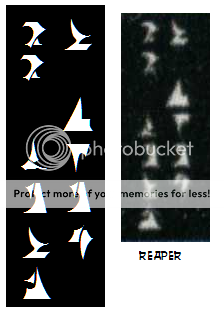
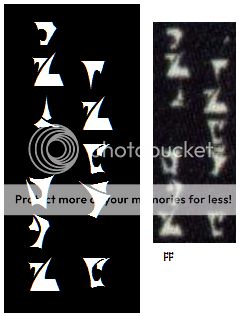
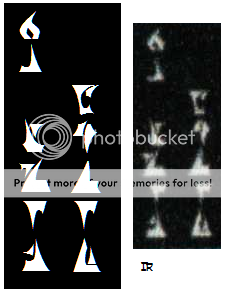
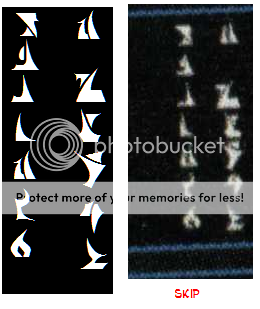
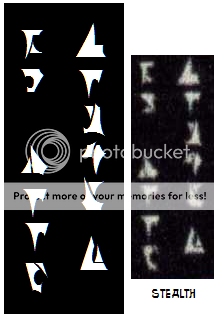
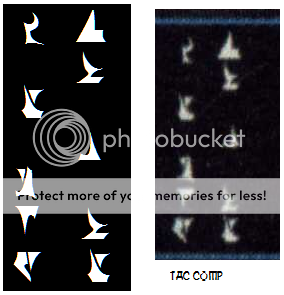
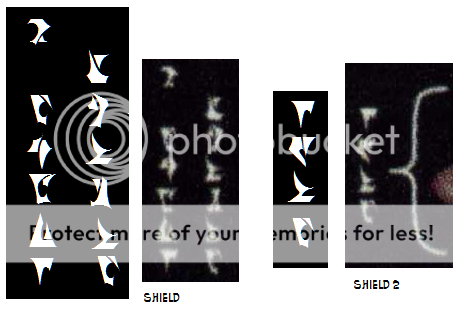
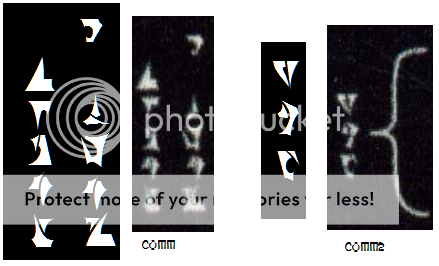
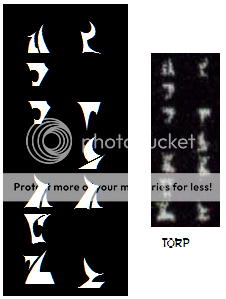
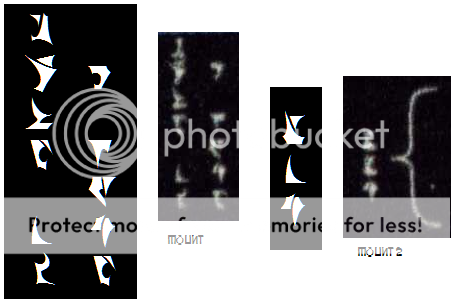
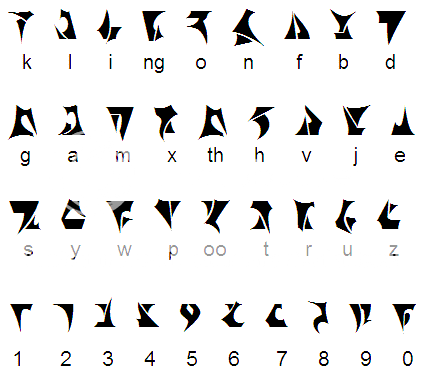
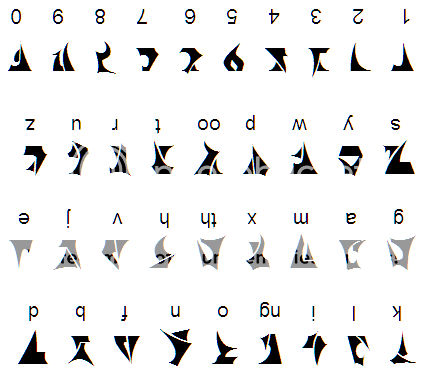
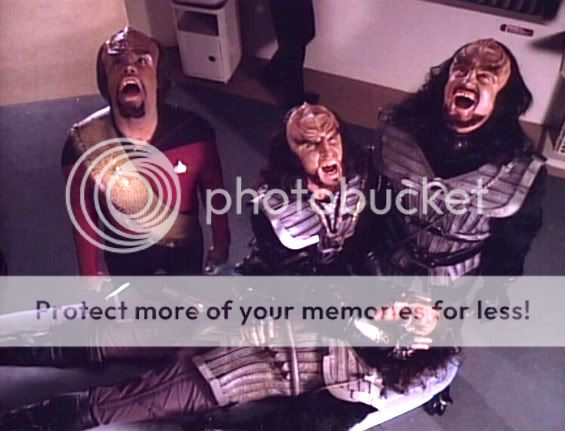

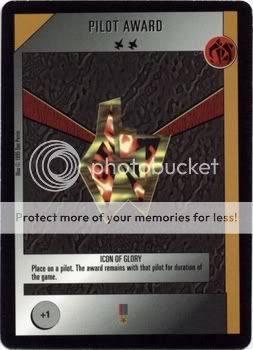
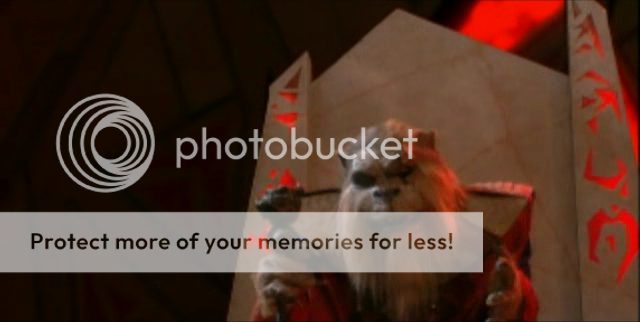
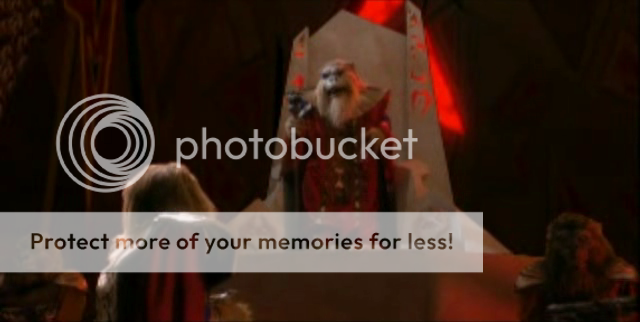
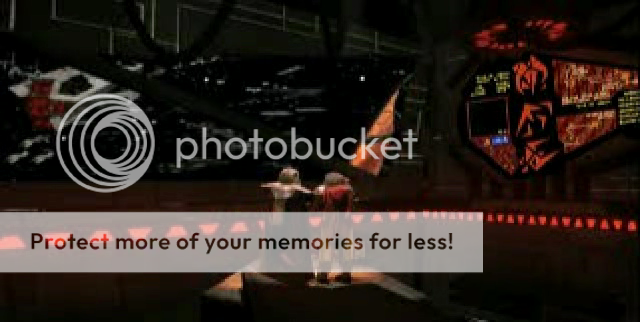



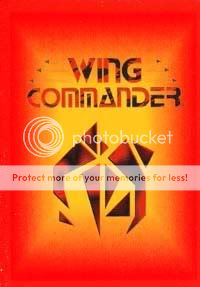
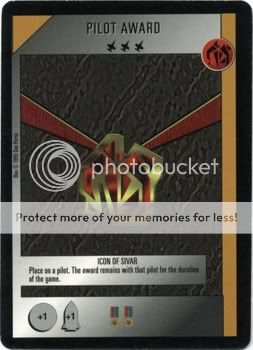
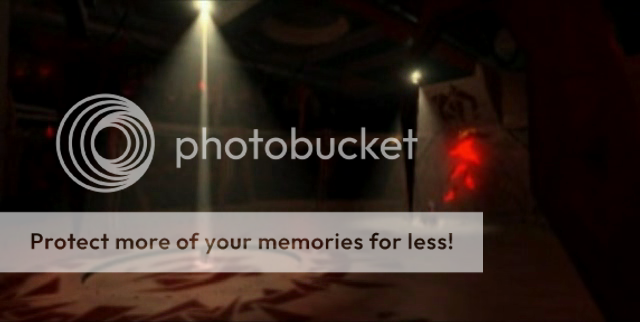




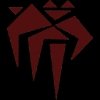








 .
.